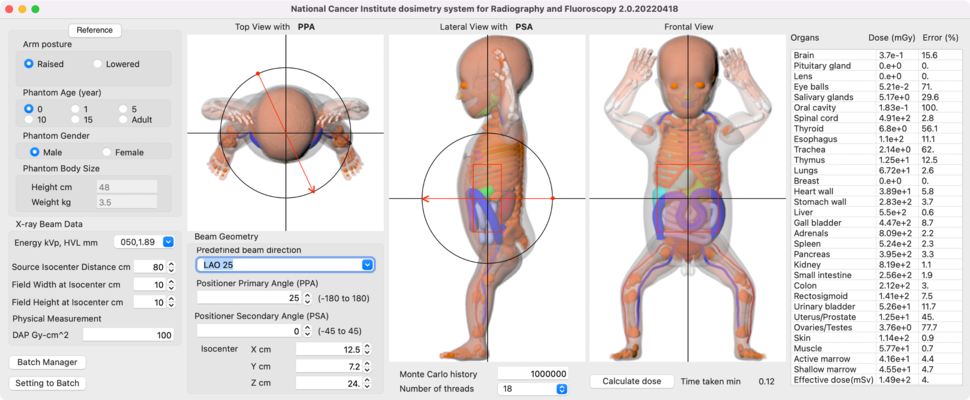The National Council on Radiation Protection and Measurements (NCRP) reported that radiography and fluoroscopy exams account for more than 20% of the mean annual individual effective dose from medical radiation sources in the United States (2.2 mSv in 2016). It is critical to monitor the radiation dose delivered to patients undergoing radiography and fluoroscopy exams to prevent both acute and potential long-term adverse health effects. Accurate estimation of organ doses is key to ensuring that radiation dose is maintained As Low As Reasonably Achievable. NCIRF, the National Cancer Institute dosimetry system for Radiography and Fluoroscopy, is a comprehensive organ dose calculator for patients undergoing radiography and fluoroscopy procedures1.
State-of-the-Art Phantoms
NCIRF features state-of-the-art pediatric and adult computational human phantoms, representing reference individuals defined by the International Commission on Radiological Protection (ICRP). The phantom library is being extended to include the phantoms with various arm postures, the body size-dependent phantom library, and pregnant women phantoms.
On-the-Fly Monte Carlo Calculations
Interventional fluoroscopy often involves x-ray irradiation at various angles, even in a single session. Dose estimation based on pre-calculated dose tables may provide substantial dosimetric errors. Hence, it is crucial to calculate organ dose using on-the-fly Monte Carlo radiation transport techniques. A 3D Monte Carlo dose calculation module, based on an extensively benchmarked Monte Carlo code, GEANT4, is built in NCIRF and running in the background. Multithreading technology is also implemented into NCIRF to speed up dose calculations.
Intuitive User Interface
NCIRF provides an intuitive graphical user interface allowing users to select from various pediatric and adult computational phantoms and enter x-ray source definitions, and finally output organ doses with statistical errors. NCIRF is running on a personal computer on Windows, Mac, and LINUX, but users also can export input files to run them on a general-purpose Monte Carlo code, MCNP, using parallel computing servers. NCIRF also features Batch Manager where users can automatically create input files and run many radiation events.
How to Access This Resource
Non-Commercial Research Use
There is no charge to use these resources for non-commercial research purposes. Please click Software Transfer Agreement form, fill out the form in your web browser*, save it to your computer, then obtain the signatures and submit it to Dr. Choonsik Lee.
*Browsers tested with the form: Safari, Microsoft Edge, Google Chrome, and Firefox.
Commercial Use
Contact Dr. Kevin Chang of the NCI Technology Transfer Center to discuss accessing the free trial version and the licensing process for commercial use.
